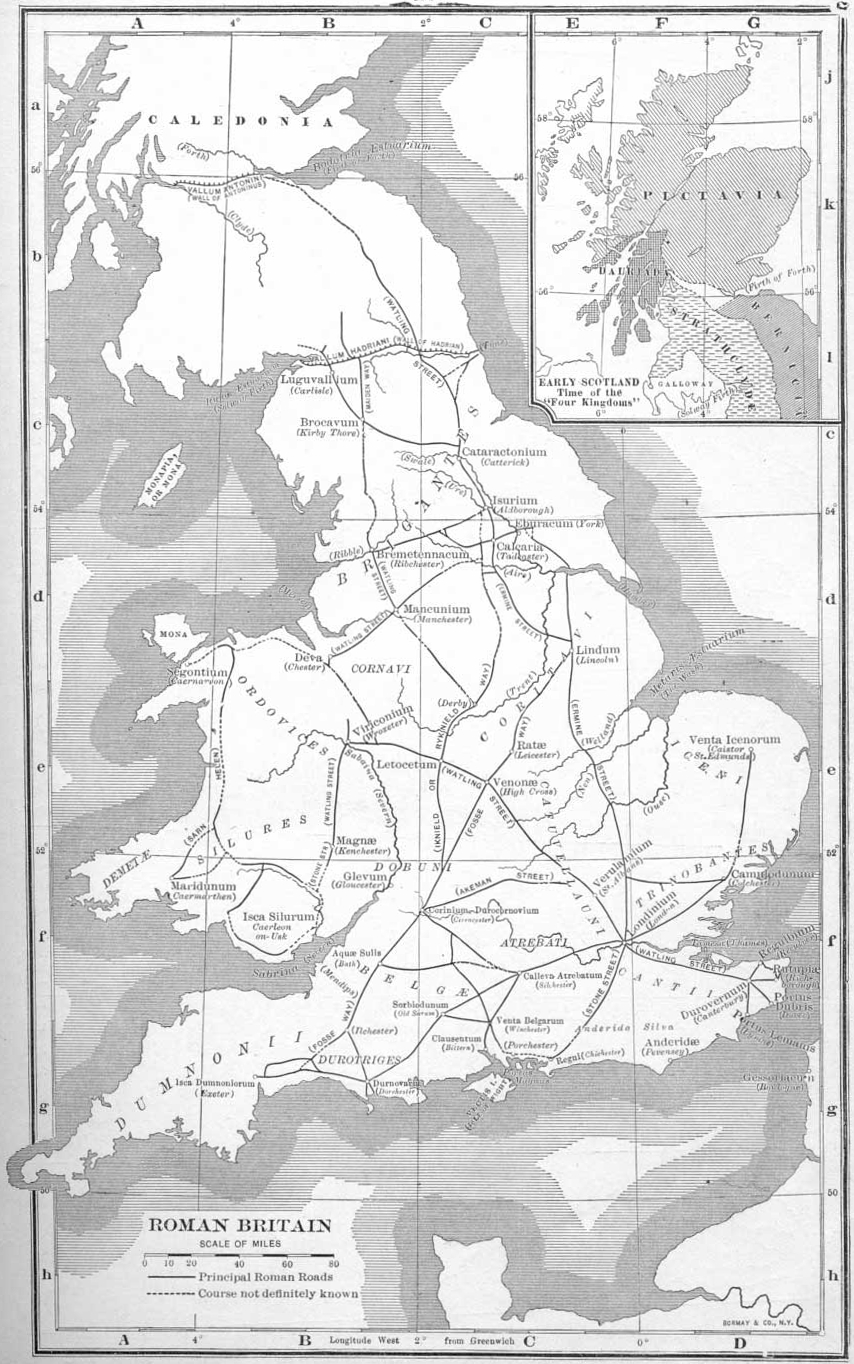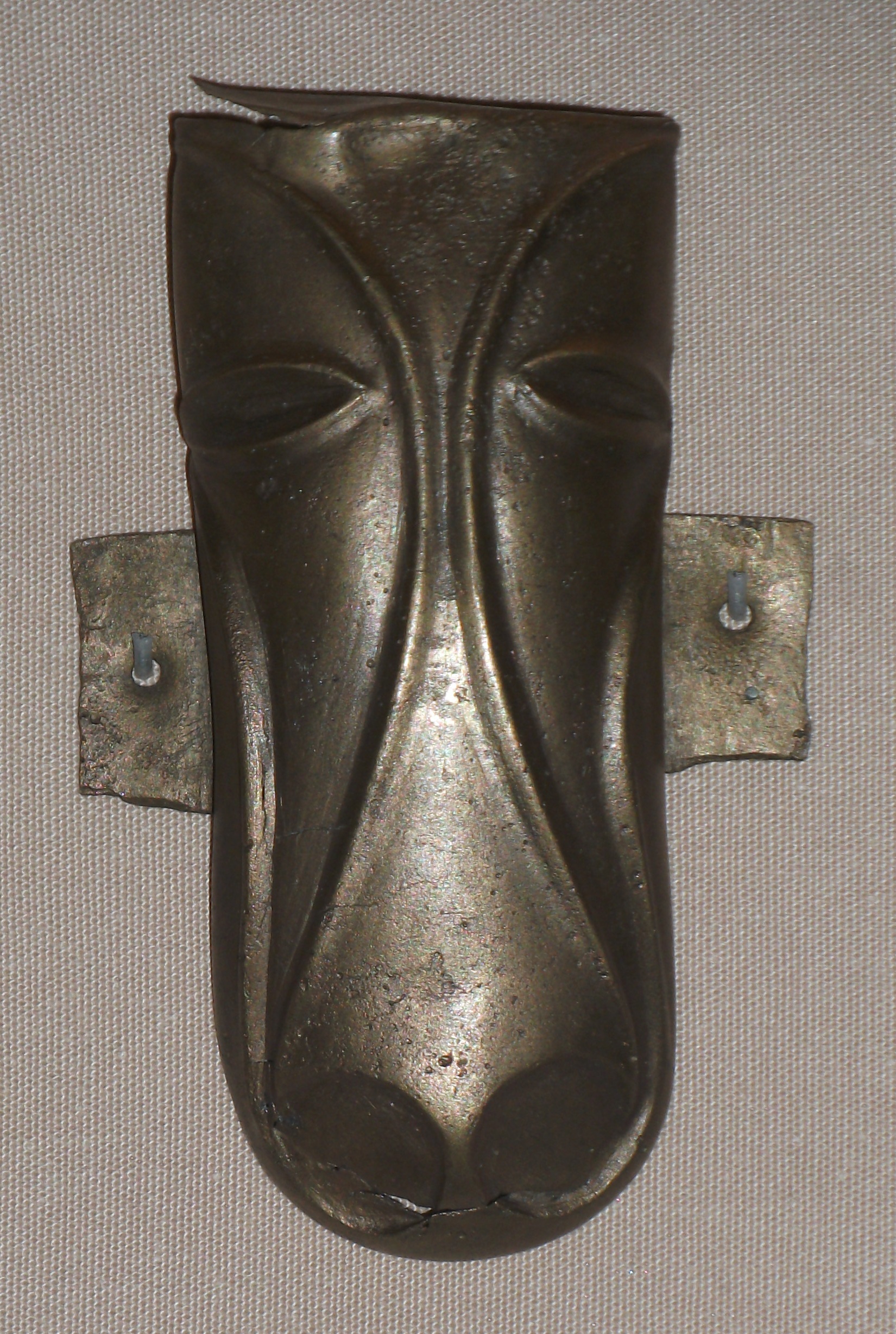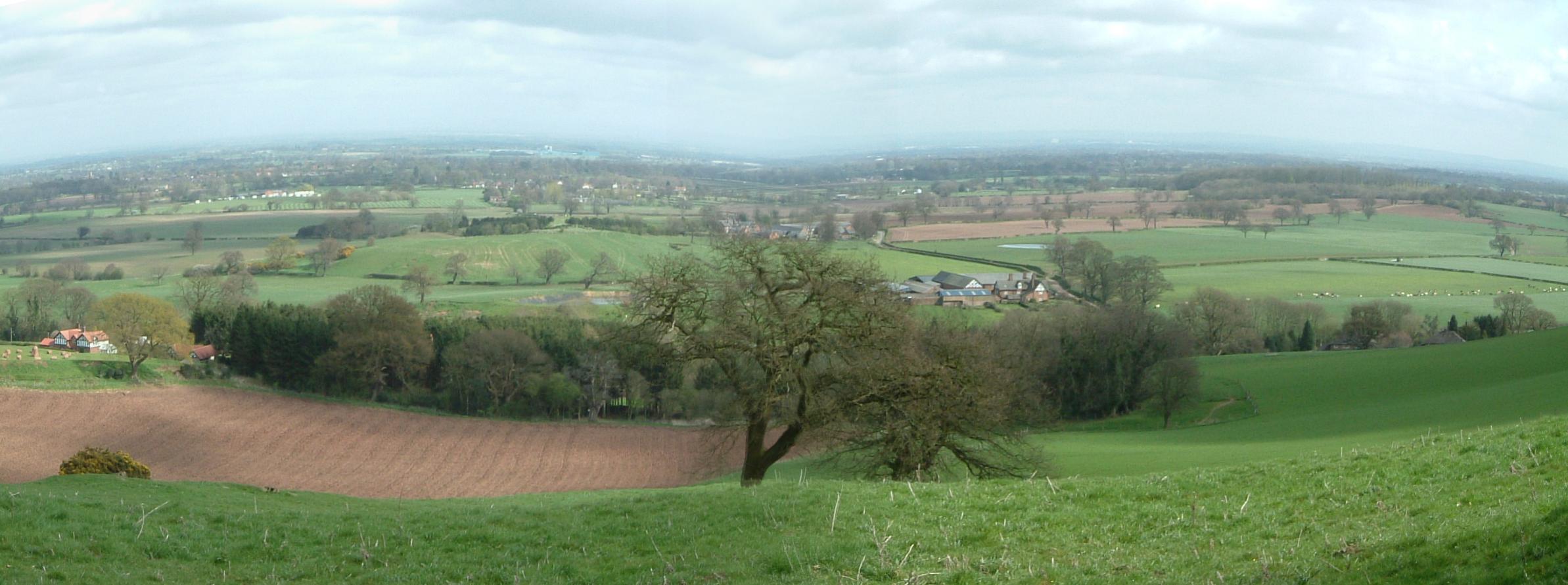|
Derby Racecourse Roman Settlement
The Derby Racecourse Roman settlement was the third settlement in Derby or Derventio which was a small town in the Roman province of Britannia. It lies 600m east of Derventio fort in Little Chester, on the outskirts of Derby, in the English county of Derbyshire. The Roman road from Derventio to Sawley on the River Trent passes the settlement. It is a scheduled National Monument. Description The first Roman fort in the area was built on the opposite bank of the River Derwent at Strutt's Park. It was replaced about AD 80 by a fort at Little Chester, but this only lasted about forty years, then decommissioned. The fort was later re-occupied and re-used for a further twenty five years then unoccupied until the late 3rd century when a stone wall was built around the town. There is evidence of extensive Roman activity in Little Chester. Derby Racecourse Roman settlement site was founded around AD 90. It is considered by English Heritage to be an import example of a fort-vicus. Th ... [...More Info...] [...Related Items...] OR: [Wikipedia] [Google] [Baidu] |
Derbyshire
Derbyshire ( ) is a ceremonial county in the East Midlands, England. It includes much of the Peak District National Park, the southern end of the Pennine range of hills and part of the National Forest. It borders Greater Manchester to the north-west, West Yorkshire to the north, South Yorkshire to the north-east, Nottinghamshire to the east, Leicestershire to the south-east, Staffordshire to the west and south-west and Cheshire to the west. Kinder Scout, at , is the highest point and Trent Meadows, where the River Trent leaves Derbyshire, the lowest at . The north–south River Derwent is the longest river at . In 2003, the Ordnance Survey named Church Flatts Farm at Coton in the Elms, near Swadlincote, as Britain's furthest point from the sea. Derby is a unitary authority area, but remains part of the ceremonial county. The county was a lot larger than its present coverage, it once extended to the boundaries of the City of Sheffield district in South Yorkshire where it cov ... [...More Info...] [...Related Items...] OR: [Wikipedia] [Google] [Baidu] |
Cornovii (Midlands)
The Cornovīī (Common Brittonic: *''Cornowī'') were a Celtic people of the Iron Age and Roman Britain, who lived principally in the modern English counties of Cheshire, Shropshire, north Staffordshire, north Herefordshire and eastern parts of the Welsh counties of Flintshire, Powys and Wrexham. Their capital in pre-Roman times was probably a hillfort on the Wrekin. Ptolemy's 2nd-century ''Geography'' names two of their towns: Deva Victrix (Chester) and Viroconium Cornoviorum (Wroxeter), which became their capital under Roman rule. Their territory was bordered by the Brigantes to the North, the Corieltauvi to the East, the Dobunni to the South, and the Deceangli, and Ordovices to the West. The people who inhabited the very north of the British mainland (modern Caithness), and Cornwall were also known by the same name, but according to mainstream or academic opinion were quite separate and unrelated peoples. (see list of ancient Celtic peoples and tribes). The problem of trib ... [...More Info...] [...Related Items...] OR: [Wikipedia] [Google] [Baidu] |
Brigantes
The Brigantes were Ancient Britons who in pre-Roman times controlled the largest section of what would become Northern England. Their territory, often referred to as Brigantia, was centred in what was later known as Yorkshire. The Greek geographer Ptolemy named the Brigantes as a people in Ireland also, where they could be found around what is now Wexford, Kilkenny and Waterford, while another people named ''Brigantii'' is mentioned by Strabo as a sub-tribe of the Vindelici in the region of the Alps. Within Britain, the territory which the Brigantes inhabited was bordered by that of four other peoples: the Carvetii in the northwest, the Parisii to the east and, to the south, the Corieltauvi and the Cornovii. To the north was the territory of the Votadini, which straddled the present day border between England and Scotland. Etymology The name ''Brigantes'' (Βρίγαντες in Ancient Greek) shares the same Proto-Celtic root as the goddess Brigantia, ''*brigant-'' meaning ... [...More Info...] [...Related Items...] OR: [Wikipedia] [Google] [Baidu] |
Tacitus
Publius Cornelius Tacitus, known simply as Tacitus ( , ; – ), was a Roman historian and politician. Tacitus is widely regarded as one of the greatest Roman historiography, Roman historians by modern scholars. The surviving portions of his two major works—the Annals (Tacitus), ''Annals'' (Latin: ''Annales'') and the Histories (Tacitus), ''Histories'' (Latin: ''Historiae'')—examine the reigns of the Roman emperor, emperors Tiberius, Claudius, Nero, and those who reigned in the Year of the Four Emperors (69 AD). These two works span the history of the Roman Empire from the death of Augustus (14 AD) to the death of Domitian (96 AD), although there are substantial Lacuna (manuscripts), lacunae in the surviving texts. Tacitus's other writings discuss Public speaking, oratory (in dialogue format, see ''Dialogus de oratoribus''), Germania (in Germania (book), ''De origine et situ Germanorum''), and the life of his father-in-law, Gnaeus Julius Agricola, Agricola (t ... [...More Info...] [...Related Items...] OR: [Wikipedia] [Google] [Baidu] |
Gnaeus Julius Agricola
Gnaeus Julius Agricola (; 13 June 40 – 23 August 93) was a Roman general and politician responsible for much of the Roman conquest of Britain. Born to a political family of senatorial rank, Agricola began his military career as a military tribune under Governor Gaius Suetonius Paulinus. In his subsequent career, he served in a variety of political positions in Rome. In 64, he was appointed quaestor in Asia (Roman province), Asia province. Two years later, he was appointed Plebeian Tribune, and in 68, he was made praetor. During the Year of the Four Emperors in 69, he supported Vespasian, general of the Roman Syria, Syrian army, in his bid for the throne. When Vespasian became Roman emperor, emperor, Agricola was made a Patrician (ancient Rome), patrician and appointed governor of Gallia Aquitania. In 77, he was made Roman consul, consul and Governor of Roman Britain, governor of Britannia. As governor, he completed the conquest of what is today Wales and northern England, and le ... [...More Info...] [...Related Items...] OR: [Wikipedia] [Google] [Baidu] |
Cartimandua
Cartimandua or Cartismandua (reigned ) was a 1st-century queen of the Brigantes, a Celtic people living in what is now northern England. She came to power around the time of the Roman conquest of Britain, and formed a large tribal agglomeration that became loyal to Rome. The only account of her is by the Roman historian Tacitus, through which she appears to have been widely influential in early Roman Britain. Her name may be a compound of the Common Celtic roots ''*carti-'' "chase, expel, send" and ''*mandu-'' "pony". History Although Cartimandua is first mentioned by Tacitus in AD 51, her rule over the Brigantes may have already been established when the Roman emperor Claudius began the organised conquest of Britain in 43: she may have been one of the eleven "kings" who Claudius's triumphal arch says surrendered without a fight. If not, she may have come to power after a revolt of a faction of the Brigantes was defeated by Publius Ostorius Scapula in 48. Being of "illustrious ... [...More Info...] [...Related Items...] OR: [Wikipedia] [Google] [Baidu] |
Gaius Suetonius Paulinus
Gaius Suetonius Paulinus (fl. AD 41–69) was a Roman general best known as the commander who defeated the rebellion of Boudica. Early life Little is known of Suetonius' family, but it likely came from Pisaurum (modern Pesaro), a town on the Adriatic coast of Italy. He is not known to be related to the biographer Suetonius.A. R. Birley, "Suetonius Paullinus, Gaius (fl. c.AD 40–69)", ''Oxford Dictionary of National Biography'', Oxford University Press, 2004; online edn, May 2006accessed 9 May 2014/ref> Mauretanian campaign Having served as ''praetor'' in 40 AD, Suetonius was appointed governor of Mauretania the following year. In collaboration with Gnaeus Hosidius Geta, he suppressed the revolt led by Aedemon in the mountainous province that arose from the execution of the local ruler by Caligula. In 41 AD Suetonius was the first Roman commander to lead troops across the Atlas Mountains, and Pliny the Elder quotes his description of the area in his '' Natural History''. Governor ... [...More Info...] [...Related Items...] OR: [Wikipedia] [Google] [Baidu] |
Quintus Veranius
Quintus Veranius (died AD 57) was a distinguished Roman general around the mid-first century CE. He was ''III vir monetalis'', tribune of Legio IV ''Scythica'' and quaestor under Tiberius. He was appointed tribune of the plebs in 41 and praetor in 42. In 43, the Emperor Claudius constituted the new province of Lycia, and appointed Veranius as its governor. He governed the province until 48, and during this period put down the rebellion of Cilicia Trachea. He served as consul in 49, and was elevated to patrician status by Claudius, who also appointed him as an augur. __NOTOC__ Veranius became governor of Britain in 57, replacing Aulus Didius Gallus. He reversed Didius's policy of maintaining existing borders and began military operations against the troublesome Silures in what is now Wales, but died within a year. In his will he flattered Nero and claimed that, had he had another two years, he would have conquered the whole of the island. He was replaced by Gaius Suetonius Paulinus, ... [...More Info...] [...Related Items...] OR: [Wikipedia] [Google] [Baidu] |
Silures
The Silures ( , ) were a powerful and warlike tribe or tribal confederation of ancient Britain, occupying what is now south east Wales and perhaps some adjoining areas. They were bordered to the north by the Ordovices; to the east by the Dobunni; and to the west by the Demetae. Origins According to Tacitus's biography of Agricola, the Silures usually had a dark complexion and curly hair. Due to their appearance, Tacitus believed they had crossed over from Spain at an earlier date."... the swarthy faces of the Silures, the curly quality, in general, of their hair, and the position of Spain opposite their shores, attest to the passage of Iberians in old days and the occupation by them of these districts; ..." (Tacitus Annales Xi.ii, translated by M. Hutton) Jordanes, in his Origins and Deeds of the Goths, describes the Silures. "The Silures have swarthy features and are usually born with curly black hair, but the inhabitants of Caledonia have reddish hair and large loose-joint ... [...More Info...] [...Related Items...] OR: [Wikipedia] [Google] [Baidu] |
Rossington
Rossington is a civil parish and former mining village in the Metropolitan Borough of Doncaster in South Yorkshire, England and is surrounded by countryside and the market towns of Bawtry and Tickhill. Geography Historically part of the West Riding of Yorkshire, it has a population of 13,255, increasing to 13,557 at the 2011 Census. Robin Hood Airport Doncaster Sheffield is around two miles to the east. The village is demarcated to the north and west by a line of 400 kV pylons, as seen from the M18, to the north. The Finningley and Rossington Relief Road Scheme – from Junction 3 of the M18 to Parrot's Corner (junction of the A638 and the B6463 roads) – is proposed to allow access to the airport. Construction was due to start in late summer 2012 though initial site clearance work only commenced in early 2013. To the north-west, the village borders Loversall, with the boundary following the River Torne, passing directly next to the western edge of the former Rossingto ... [...More Info...] [...Related Items...] OR: [Wikipedia] [Google] [Baidu] |
Wroxeter
Wroxeter is a village in Shropshire, England, which forms part of the civil parish of Wroxeter and Uppington, beside the River Severn, south-east of Shrewsbury. ''Viroconium Cornoviorum'', the fourth largest city in Roman Britain, was sited here, and is gradually being excavated. History Roman Wroxeter, near the end of the Watling Street Roman road that ran across Romanised Celtic Britain from '' Dubris'' (Dover), was a key frontier position lying on the bank of the Severn river whose valley penetrated deep into what later became Wales following brytons fall to the Anglo Saxons, and also on a route to the south leading to the Wye valley. Archaeology has shown that the site of the later city first was established about AD 55 as a frontier post for a Thracian legionary cohort located at a fort near the Severn river crossing. A few years later a legionary fortress (''castrum'') was built within the site of the later city for the Legio XIV Gemina during their invasion o ... [...More Info...] [...Related Items...] OR: [Wikipedia] [Google] [Baidu] |
Cheshire Plain
The Cheshire Plain is a relatively flat expanse of lowland within the county of Cheshire in North West England but extending south into Shropshire. It extends from the Mersey Valley in the north to the Shropshire Hills in the south, bounded by the hills of North Wales to the west and the foothills of the Pennines to the north-east. The Wirral Peninsula lies to the north-west whilst the plain merges with the South Lancashire Plain in the embayment occupied by Manchester to the north. In detail, the plain comprises two areas with distinct characters, the one to the west of the Mid Cheshire Ridge and the other, larger part, to its east. The plain is the surface expression of the Cheshire Basin, a deep sedimentary basin that extends north into Lancashire and south into Shropshire. It assumed its current form as the ice-sheets of the last glacial period melted away between 20,000 and 15,000 years ago leaving behind a thick cover of glacial till and extensive tracts of glacio-flu ... [...More Info...] [...Related Items...] OR: [Wikipedia] [Google] [Baidu] |







